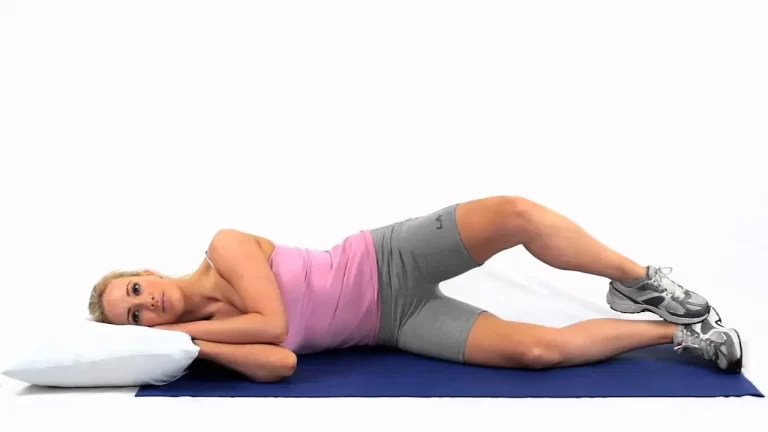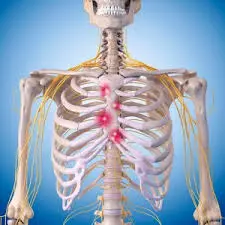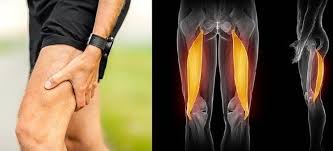21 Exercises That Are Best Before Knee Replacement Surgery
It’s important to exercise before knee replacement surgery to increase general fitness and prepare your body for the healing process and recovery period. This means strengthening your knee muscles so that the operation doesn’t damage your body, you recover from it fast, and you’re ready to support your newly placed joints.
Strengthening the muscles around your knees with exercise before a knee replacement operation may have a big impact on how fast and successfully you recover from the procedure.
However, it’s important to contact your physical therapist and surgeon before beginning any new workout program. By following these actions, the recovery process will move forward more quickly and effectively.
For what reason would someone need a knee replacement, and what is it?
Your problematic knee joint is removed during a knee replacement treatment and replaced with a metal and plastic prosthetic joint. Your shin and thigh bones are joined to the replacement joint using a unique substance that resembles acrylic cement.
Knee replacement surgery may be your final option if you have pain or a limited range of motion in your knee. If your doctor determines that medicine, injections, and physical therapy are not working, knee replacement surgery may be recommended.
Who might need knee replacement surgery?
While a variety of exercises and home treatments might provide temporary relief from knee pain, patients who have had significant damage to their knees as a result of illnesses such as osteoarthritis, rheumatoid arthritis, or post-traumatic joint injury may need to consider knee replacement surgery.
The symptoms listed below may indicate that knee replacement surgery is necessary;
- Acute and chronic knee pain.
- There is a significant restriction on movement.
- Inflammation in the knee area.
- Routine tasks become challenging.
- You’re not feeling motivated to engage in the activities you used to like.
- It’s difficult to move around, sit, stand, and climb stairs.
- Additional therapies and treatments are ineffective.
Is it beneficial to exercise after knee replacement surgery?
In general, exercise is excellent for your body. The muscles that support your knees can be strengthened by exercise, and it may even improve knee mobility. It is best to discuss which exercises are safe for you to do and which ones should be avoided with your doctor and a highly skilled physical therapist if you have knee pain or disorders such as osteoarthritis, rheumatoid arthritis, or post-traumatic arthritis.
Having a better understanding of your body’s needs and limitations will help you design an exercise program. However, if you have serious damage to your knees, knee replacement surgery is a clear alternative that you may consider. You could recover from knee replacement surgery more quickly if you perform the activities that your physical therapist recommends.
Important Functional Goal to Reach Before Surgery:
Participating in a “knee replacement rehabilitation” program, which is a pre-operative physical therapy plan that typically begins five to seven weeks before the procedure, helps patients recover from surgery more quickly.
You are going to try to achieve the following objectives by following the recommended routine of exercise and stretches after knee replacement surgery.
- Goal 1 Increased Leg Power
Increase the strength of your calf, hamstring, quadriceps, and glute muscles that support your knee joint.
- Goal 2 Increasing Your Flexibility
Your hamstrings, calf muscles, hip flexors, and quads should all be more flexible.
- Goal 3 Improve the Range of Motion in Your Knee Joint
Try to increase the range of motion in your knee joint as much as you can without making your joint pain significantly worse.
Benefits of Prior Exercises Before Knee Replacement Surgery
Pre-habilitation is exercise therapy started at least five weeks before joint replacement surgery. These focus on endurance, flexibility, and strengthening in preparation for knee replacement surgery.
- Lowering the chances that hospitalization may be required
- An increase in general fitness will help you better handle the challenges of surgery and recovery.
- Less time spent in the hospital since you heal faster
- Before surgery, exercise can help lower inflammation and relieve pain.
- Increasing flexibility so that Bending and straightening becomes less painful and easier.
- Lower stiffness and keep pain levels stable before surgery.
Basic guidelines for strengthening exercises:
Before having joint replacement surgery, it’s normal for your leg muscles to become weaker or smaller. Muscles can function more effectively and restore strength with improved nerve signals that are produced by exercise. To improve your total performance, it’s important to exercise your leg muscles in many methods.
- Strengthening workouts usually come after stretching and warm-up.
- Keep in mind to carefully return to your starting posture by using your muscles.
- Take a deep breath and relax for five to ten seconds in between every repetition.
- It’s important to give yourself six to eight minutes to relax after working out.
- It should consist of a few stretches and cold packs for sore muscles.
While some muscle pain is to be expected, these exercises shouldn’t hurt.
If you feel pain, slow up and adjust your position. If the pain continues to exist, put off the particularly challenging workout.
General suggestions for stretching exercises:
Stretching helps in injury prevention by getting the muscles ready for exercise. Stretching for two to four minutes is normally advised before beginning any kind of exercise.
- To warm up your muscles for the workout, do a short eight to ten-minute walk.
- Improve the stretch to make it more comfortable for you.
- Remember to stretch gently and slowly and do not make jerky movements.
- Take a deep breath and relax for a moment in between every repetition.
- Make sure to get back to the starting place carefully.
The best workouts to perform before having knee replacement surgery are the following:
Combine these exercises with your pre-rehabilitation program for the greatest results and a successful replacement. It takes time to recover, so be kind to yourself and mindful of your body.
Side-lying straight leg raises
This exercise helps to develop the hip abductor muscles, which are located on the side of the buttocks. These muscles support and maintain your pelvis while you stand and walk.
- Lay on your right side on the floor or on a mat.
- Your body should be in a straight line with your legs extending and your feet placed on top of one another.
- You can support your head by holding it with your elbow bent or by placing your arm straight on the floor below it.
- Move your left hand out in front of you or allow it to rest on your hip or leg for additional support.
- As you exhale, raise your left leg off your lower leg.
- As soon as you feel your lower back or obliques contract, stop lifting your leg.
- Hold this position for a few seconds.
- Then return to your neutral position.
- Then relax.
- Repeat this exercise six to eight times.
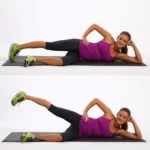
Extension of the glut
You may improve your hip and gluteal muscle strength by exercising your glutes.
- As you sleep on your stomach, use your buttocks to flex your knee and raise your leg off the bed.
- Don’t let your back get too stressed.
- Hold this position for a few seconds.
- Then return to your neutral position.
- Then relax.
- Repeat this exercise six to eight times.
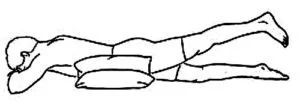
Resistance Band Seated Hamstring Curls
- A bench should be placed a few feet away from a band that is placed next to the ground.
- Setting your feet on the bench, start with your legs straight and wrap the band around your ankles.
- You are going to start here.
- Knee flexion will bring your feet up against the bench.
- You may need to slightly bend to prevent your feet from hitting the floor.
- Once you have completed the movement, stop and take a slow step back to the beginning position.
- Then relax.
- Repeat this exercise six to eight times.
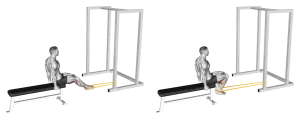
Sitting ball squeeze
The adductor ball squeeze targets the muscles in the inside thighs. A set of muscles called the adductors is necessary for maintaining the stability of the lower extremities and knees during a range of daily tasks.
- Sit upright at a table or chair’s edge to start.
- Place a ball between your knees.
- Gently squeeze your thighs together, pressing them together as well.
- Hold this position for a few seconds.
- After that release the ball without letting it fall.
- Then return to your neutral position.
- Then relax.
- Repeat this exercise six to eight times.
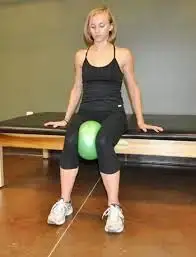
Straight leg raises
This leg raises will make your quadriceps and hip flexors stronger. This is very important for healing from surgery and building muscle.
- To start, take a comfortable lying posture on the floor or a table.
- For now, only bend one knee.
- Then, gradually lift your leg higher.
- After that, hold for just an amount while keeping your opposing knee in a straight position.
- Lower your leg after that.
- Then return to your neutral position.
- Then relax.
- Repeat this exercise six to eight times.
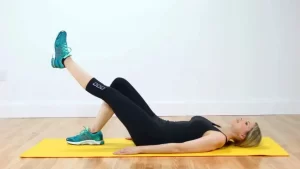
Clamshells
Your hips’ external rotators and abductors will be worked out by this. Both are necessary for initial mobility and balance.
- To begin, think about taking a place comfortably on one side of the table.
- Make your abdomen feel tight.
- Bend your knees now.
- Keep your feet together and extend your upper knee.
- Hold this position for a few seconds.
- Then slowly lower your leg.
- Then return to your neutral position.
- Then relax.
- Repeat this exercise six to eight times.
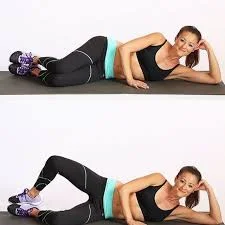
Bending the knee
This maintains your range of motion before surgery.
- Beginning by taking a comfortable seat in the chair.
- Move forward into the area’s center.
- Place your foot back on one leg as near to the chair as you can.
- Hold this position for a few seconds.
- Then return to your neutral position.
- Then relax.
- Repeat this exercise six to eight times.
- Make sure you move carefully and properly.

Knee extension
The entire range of motion of the quadriceps muscle gets strengthened as a result.
- Start with taking a seat in a chair.
- Straighten one leg while seated in a sturdy chair.
- Hold this position for a few seconds.
- Gradually lower your leg.
- Then return to your neutral position.
- Then relax.
- Repeat this exercise six to eight times.
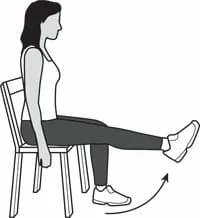
Short arc quadriceps exercise
The sense of balance of the knee joint can be improved with this practice. prevents muscle imbalances and improves flexibility. This workout strengthens the quadriceps as well.
- If you are sitting on the floor or in bed, place a rolled blanket under your painful knee.
- For a few seconds, keep your leg and knee straight and maintain that posture.
- Lower your leg gradually, then take a seat.
- Ensure that your knee is in constant touch with the towel.
- Then return to your neutral position.
- Then relax.
- Repeat this exercise six to eight times.
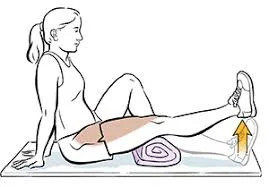
Prone straight leg raise
The muscles in your hamstrings and glutes become stronger with this workout. These muscles are required for getting into and out of transportation.
- Start in a relaxed prone position on a table or bed.
- Slowly raise your whole leg off the table.
- Trying to keep your knee straight while.
- Give it a few moments there.
- Lower your leg, kindly.
- Then return to your neutral position.
- Then relax.
- Repeat this exercise six to eight times.
Ankle pumps
Ankle pumps are a quick, easy, and effective exercise that keeps joints flexible, lowers edema, and stops blood clots.
- Start by putting your feet out in front of you while sitting or lying down on a firm bed.
- You may perform these on the ground as well.
- Try to keep your feet as close to your knees as you can.
- Then, try your best to pull them away from you.
- That’s the only thing about it.
- All you have to do is point and bend your feet as far in each direction alternately.
- For around two to four minutes, keep going.
- Then return to your neutral position.
- Then relax.
- Repeat this exercise six to eight times.
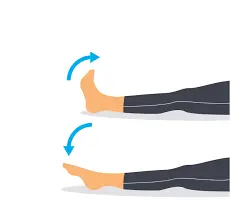
Ankle circles
- Start with taking a relaxing seating position on the chair.
- Make use of a supportive chair that lets you rest comfortably on both feet.
- For extra stability and support throughout this exercise, put your hands on the chair’s edge by your sides.
- With a small bend in the knee, extend one leg straight out in front of you.
- Ten times around your ankle in one direction, and ten times around it in the opposite direction.
- Then return to your neutral position.
- Then relax.
- Repeat this exercise six to eight times.
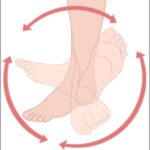
Heel slides
Heel slides are an excellent way to strengthen the tendons, ligaments, and muscles in your legs and hips.
- To start, take a comfortable position lying down on the bed or table.
- The afflicted leg should then be moved toward the buttocks while bending at the knees.
- Try to put your heels on the buttocks.
- Feel about it until you settle into a relaxed posture.
- For a short while, hold it.
- Now slowly straighten your leg.
- Then return to your neutral position.
- Then relax.
- Repeat this exercise six to eight times.
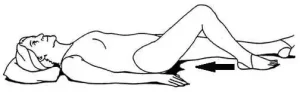
Leg slides (abduction/adduction)
You can prevent pain and future damage while also restoring your range of motion by strengthening these muscles through exercise.
- Begin by lying down on the bed and resting.
- Extend your leg out to the side while maintaining an upward kneecap position.
- Hold this position for a few seconds.
- Slide your leg back to take yourself back to the starting position.
- Then return to your neutral position.
- Then relax.
- Repeat this exercise six to eight times.
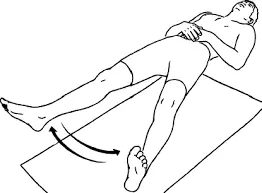
Calf raise
This workout works the calf muscles. For this exercise, we recommend using a chair, counter, or barrier for balance.
- Grab the back of a chair and maintain a straight posture on the ground.
- Keeping your balance and your legs straight, release your grip on the air and raise your toes.
- Continue elevating yourself until you are unable to stand much higher on your toes.
- Hold this position for a few seconds.
- Then return to your neutral position.
- Then relax.
- Repeat this exercise six to eight times.
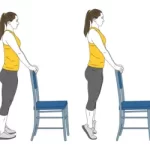
Quad Sets
By engaging and strengthening the quadriceps, quad sets improve knee stability, and function, and support the knee joint.
- Sitting or lying down on a solid bed or the floor, straighten one leg.
- Put a small, folded towel under your knee.
- One leg should be bent and your foot should be flat on the ground.
- In your straight leg, contract your quadriceps, or thigh muscles, by pressing the towel against the back of your knee.
- Take a ten-second rest after holding this position for around a few seconds.
- Then return to your neutral position.
- Then relax.
- Repeat this exercise six to eight times.
Prone knee bend
It is also an effective method of targeting and strengthening the vastus medialis obliquus, a muscle essential for knee stability.
- On the bed or table, take a comfortable position while lying prone.
- Now, slowly bend your knee into an upright position.
- Hold this position for a few seconds.
- Then, gradually lower your leg again.
- Then return to your neutral position.
- Then relax.
- Repeat this exercise six to eight times.
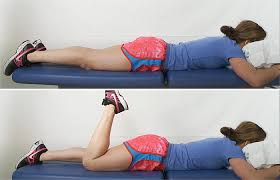
Side-Lying Quadricep Stretch
- Begin by resting on your side comfortably on the ground.
- Gently pull with your hand to bend the knee of your upper leg as far as possible.
- Hold this position for a few seconds.
- Then return to your neutral position.
- Then relax.
- Repeat this exercise six to eight times.

Hip Abduction
In addition to providing you with a tight, toned rear end, hip abduction exercises can help you avoid and manage hip and knee problems.
- To help support yourself while you lie on your side, extend the injured upper leg and bend the lower one.
- Maintain a straight but unlocked knee.
- Lift your upper leg to a 45° angle while lying straight up.
- Hold this position for a few seconds.
- Lower your leg.
- Then return to your neutral position.
- Then relax.
- Repeat this exercise six to eight times.
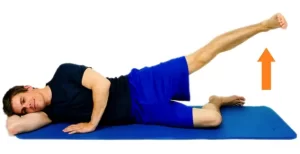
Standing Hip Extension
Activating the gluteal muscles, which allows complete hip extension and upright sitting and standing, is an additional benefit of standing hip extension for a range of daily activities, including walking and climbing.
- Begin by taking a comfortable standing position on the ground.
- For stability, make sure your hands are on a table or chair.
- Extend one leg straight back toward the ceiling while keeping your knee straight.
- Maintain this posture while concentrating on tensing your glute muscles.
- Hold this position for a few seconds.
- Then return to your neutral position.
- Then relax.
- Repeat this exercise six to eight times.
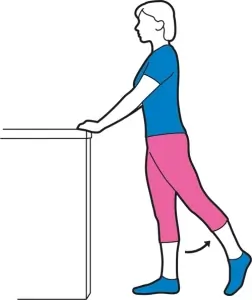
Walking
- Walking for a few minutes is useful as a warm-up and cool-down after strength training.
- Increase your activity level to burn calories and lose weight.
- If you are overweight, losing weight can help you heal more quickly and reduce your chances of complications.

Safety measures to take during exercise:
- If you get pain while exercising, stop.
- When exercising, avoid making quick knee movements.
- Stretch, hold, and perform the exercise correctly.
- When exercising, wear loose clothes so your body may move freely.
- Every exercise should be completed under protocol, which includes stretches before, holds between, and the right amount of repetitions for each exercise.
- Breathing should never be held during exercise.
- When exercising, you should take deep breaths and exhale slowly.
- Deep breathing causes your muscles to stiffen, which raises blood pressure.
What to Do and Not Do:
- Consult your physician before starting an exercise therapy for knee replacement surgery.
- When you exercise, use both legs, even if your knee replacement surgery only involved the replacement of one.
- Your knees need to be solid on both sides.
- Since each patient is different, treating a particular issue may need different activities.
- You need to stop performing the workout if it hurts or is painful for you.
- Daily exercise is necessary to develop the knee muscles.
- Taking precautions is the most wise choice for activity.
- While exercising, try not to move quickly.
Summary
Before having surgery, exercise not only helps you stay fit but also contributes to your body for the best knee replacement recovery. Regaining full mobility more quickly and painlessly is made possible by stronger muscles, more flexibility, and improved general fitness. A quicker, more effective recovery from a knee replacement is possible if pre-surgery activity is focused.
Consult your physical therapist, who will design an exercise program according to your requirements and limitations. Increase the speed and intensity gradually. Observe your body and avoid from exerting yourself excessively. To prepare your muscles and avoid injuries, warm up and cool down. At least 20 to 25 minutes should be spent on these exercises each day.
Although each person is unique, make adjustments and pay careful attention to your body. If you have any queries or worries, let your doctor know.
FAQs
Which exercises are recommended before a knee replacement?
Side-lying straight leg raises.
Straight leg raises.
Clamshells.
Knee bending.
Prone knee bends
Will my range of motion and flexibility be fully restored after knee replacement surgery?
Most of the activities and exercises you could do before your knee replacement surgery will be safe to resume after surgery; It is recommended that you avoid difficult tasks and workouts that can place excessive strain on your knee implants. Among the examples are sports involving physical contact, running, and utilizing Indian-style latrines.
Should you work out before having knee replacement surgery?
Strengthening your muscles and mentally preparing yourself for the recovery process are two benefits of exercising before surgery.
Before having knee replacement surgery, what should You avoid?
You need to stay away from doing anything that could cause the skin surrounding your wounded knee to get damaged before undergoing a knee replacement. Surgeons need skin that is healthy and free from damage to perform surgery.
Why is working out before surgery necessary?
Slightly better physical condition lowers the risk of surgical complications. Your body is more capable of enduring the strain caused by the procedure, which explains it. That way, you can get out of the hospital and get back to your regular life sooner rather than later if issues arise more frequently.
Does exercise help in the healing process after surgery?
Physical therapy, continued exercise, and strength training are essential parts of your rehabilitation following surgery. It can speed up your healing and improve your range of motion while also helping you manage your pain and take better care of your emotional health.
Should I exercise the morning before my surgery?
It has been revealed that exercise before surgery helps individuals recover more quickly. Before major surgery, patients who exercise may be able to avoid frequent complications such as heart problems, stomach problems, and pneumonia.
For how long of a time a day do you exercise?
Generally speaking, try to take part in light physical activity for at least 30 to 40 minutes each day.
Can you get exhausted from exercising?
Exercise affects the internal environment’s ongoing condition since it raises body temperature and produces metabolites. Tiredness and exhaustion will ultimately set in, depending on the type of exercise.
What sort of exercise is best after knee replacement surgery?
Other than physical therapy activities, walking is one of the most important exercises after a knee replacement. It increases mobility and builds up the muscles that surround the new joint. You should be able to walk independently after about a week, though at first, you could have walking aids.
Do all knee replacements require surgery?
A knee replacement is a significant surgery that is usually advised only as the last option when conservative measures, such as steroid injections or physical therapy, have failed to reduce pain or restore range of motion.
What is the average age of knee replacement surgery?
Elderly patients with severe arthritis are usually the ones who undergo knee replacement surgery; however, younger patients under 50 should postpone the surgery until they are 65 years old. This is due to the short 15–20-year lifetimes of the prosthetic joints utilized in knee replacement procedures.
How come knee replacements are so common?
Knee replacement surgery is most commonly performed to treat pain associated with arthritis. Individuals who require knee replacement surgery typically have trouble getting out of seats, walking, and climbing stairs. Surgeons can typically replace the damaged portion of the knee if only one component is affected.
Is it possible to replace both knees at one time?
Patients can get back to their regular lives more quickly when both knees are replaced at the same time. Individuals only experience one surgery, one hospital stay, and one therapy session. Patients typically take fewer vacation days from their jobs.
References:
- J. T. Moskal (January 4, 2012). Outcomes of Total Knee Replacement for Medical Professionals and Patients. JBJS Orthopaedic Highlights, 2(1): Knee Surgery. 10.2106/jbjs.ks.k.00175 is the URL. cited in the text as Moskal, 2012
- On November 24, 2020, Hollander, R. Pre-habilitation exercises are to be performed before knee replacement surgery. Alpine Physical Therapy & Spine, Inc. Exercises for knee replacements before surgery: In 2020, June 02, https://www.alpinephysicaltherapy.com Inside text reference: (Hollander, 2020)
- Nov. 24, 2023, S. Bhatia. Workouts that could be helpful both before and after knee replacement surgery. The PharmaEasy Blog. You may benefit from performing these workouts both before and after having a knee replacement: the pharmacy is easy.in/blog/ Inside text reference: (Bhatia, 2023)
- April 13, 2020 / Greengard, S. Before Having a Total Knee Replacement, Try These 10 Exercises to Gain Strength. Fitness Routines for Total Knee Replacement: Html/thigh-squeezes on https://www.healthline.com Greengard (2020) is cited within the book.
- May 31, 2023; Miller, M. Exercises to Get Ready for a Successful Knee Replacement. Phoenix Metro Foothills Physical Therapy & Sports Medicine https://foothillsrehab.com/blog/10-prehab-exercises-knee-replacement Miller, 2023 is cited in the text.
- July 8, 2022, Briones, who L. These five workouts are for pre-rehabilitation before knee surgery. Five pre-rehabilitation exercises can be completed before knee surgery according to the Endeavor Clinical Trials website. Briones, 2022 is cited in the book.
- Achievement Health, n.d., “13 Activities to Do Before Knee Replaced Surgery” Knee Replacement Surgery Preoperative Exercises: /articles/13 on https://www.performancehealth.com (13 Knee Replacement Activities | Performance Health, n.d.) is the internal citation.
- Try these three workouts before you have knee replacement surgery | Performance Health (n.d.). Preoperative Exercises for Knee Replacement Surgery: /articles/13 on https://www.performancehealth.com Internal citation: (13 Knee Replacement Activities | Performance Health, n.d.)
- Image 2, L. (25 February 2016). Four Easy Steps To Get Your Glutes Burning. https://in.pinterest.com/pin/422071796339649506/Citation within the text: (2016)
- Image 3, Luna, D., “The 7 Finest Resistance Band Hamstring Exercises” (May 24, with pictures!). Inspire America. You can get hamstring workouts with resistance bands at https://www.inspireusafoundation.org.
Luna, 2023, as an internal reference - Image 4, Seated ball squeeze. (n.d.). Ball squeeze sitting exercises: https://www.spineandsportspt.org/
Reference inside text: Ball Squeeze-Seated, n.d. - Image 7, 2023, February 24. Seated knee flexion – OPAL – Return to Work. OPAL: Go Back to Work. Exercises/seated-knee-flexion: https://www.opalreturntowork.nhs.uk/
In-text Citation: (Knee Flexion While Seated – OPAL – Return) - Image 11, Innovations in Orthopedic Care: Zimmer Biomet. April 4, 2024. https://www.zimmerbiomet.com/en Zimmer Biomet
Inside-Text Reference: Zimmer Biomet: Pioneers in Orthopedics - Image 12, M. Rabbitt (2021, Nov. 2). To Improve Your Health, Try These 8 Stretches While Watching TV. Preventive measures. Eight stretches to perform while watching TV to improve your health can be found at https://www.prevention.com/fitness/a20432328.
Citation inside the text: (Rabbitt, 2021) - Image 19, S. May (2016) 22 January. Quad Stretching While Lying on Your Side. https://www.popsugar.com/fitness/side-lying-quad-stretch-39485197
Citation within the text: May, 2016



